*This is an excerpt from Beef Cattle Management in Uncertain Times
Keep you and your workers safe when applying herbicides and pesticides. The Route of Entry Video Part 1 discusses the primary ways you can be exposed to pesticides, acute versus chronic toxicity, and poisoning symptoms. Note that 97 percent of all exposure is through the skin. The liver and the kidneys are the primary organs that filter and break down chemicals in the body. Poisoning symptoms vary widely, and how your body responds to breaking down a chemical varies on the exposure over time, toxicity, and dosage.
The Route of Entry Video Part 2 looks at first-aid procedures and labeling of pesticides to help the victim while waiting for medical help. Read the label to ensure the safety of humans, livestock, wildlife, and the environment. In case of accidental pesticide exposure, the label and safety data sheets (SDS) provide information for applicators as well as emergency and medical personnel.
This video discusses different types of personal protective equipment (PPE) that can be used to protect you and your workers when applying pesticides and herbicides. Cleaning, disposing of, and storing PPE are also covered. Wear PPE for any task that could expose your skin, mouth, eyes, or lungs. Read product labels to determine PPE requirements.
Finally, this video discusses pesticide cleanup procedures. Pesticide accidents and emergencies can damage property, the environment, and wildlife. They can also endanger the health of the applicator and first responders and cause financial loss and liability claims. It is important to prevent and follow the correct cleanup procedures if a pesticide accident occurs.
Read more about Beef Cattle Management in Uncertain Times
Read More related articles
